
Galapagos Islands
Isabela
April 2010
Part Three
| |
| HOME |
| About Tenaya |
| About Us |
| Latest Update |
| Logs from Current Year |
| Logs from Previous Years |
| Katie's View |
| Route Map |
| Links |
| Contact Us |
![]()
April 28, 2010
At 0615 Wednesday, April 21, Tenaya motored out of the rolly Puerto Ayora anchorage at Isla Santa Cruz and headed west to Isla Isabela. The rain clouds cleared quickly and by 0800 we had sunny skies with southeast winds 11-16 knots. The favorable current helped us make 6-7 knots.
We sailed past picturesque Isla Tortuga which was a volcano long ago. Most of it has eroded and sunk into the sea but a crescent shaped portion remains with the flanks rising steeply out of the water. It would be fascinating to explore more of these islands but in our sailboat we are limited to a single anchorage on each of three islands.
After winding our way in through the black rocks that litter the coast and reminded us of past volcanic eruptions, we arrived at the Puerto Villamil anchorage at 1630.
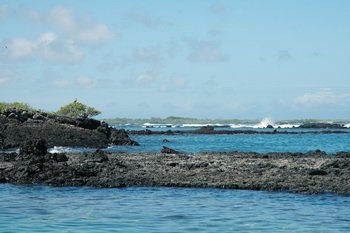
Volcanic rocks and islets around the anchorage at Puerto Villamil
What a wonderful anchorage! Surrounded by black lava islets trimmed with cacti and mangroves, the boat rests quietly at the furthest point in. There is less room than it appears because of many rocks so we followed the lead of Aurora-B, an HR42, and put out a stern anchor. Following boats did the same and it has worked nicely.
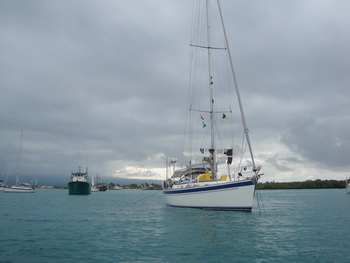
Tenaya at Puerto Villamil, Isabela
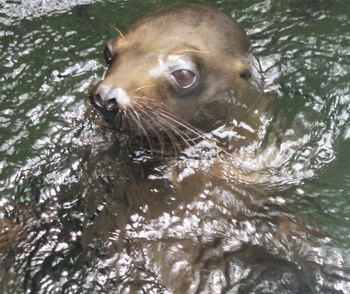
Curious sea lion
Sea lions play around the boats and one day I looked over the side to find one in our dinghy. He looked at me with his big brown eyes like a puppy that knows he's in trouble and slowly slipped over the side into the water. Guess he has been chased away before. Turtles swim by from time to time but the best part of this place are the penguins. Yes, penguins! They are small, about 20 inches long, and swim slowly through the anchorage until they spot some fish. Then they honk and dart like speeding bullets through the water. At 0600 each morning there are a dozen or more feeding among the boats. What a great way to start the day.
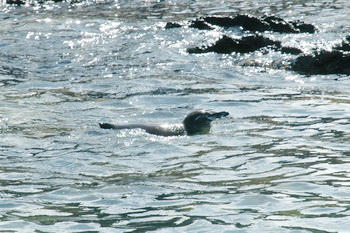
A penguin swims through the anchorage
Although the air temperature is warm the water is cool. The cold Cromwell Current flows from the west under the South Equatorial Current from the east. The South Equatorial Current is made up of cold water from the Humbolt current that flows up the South American coast and warm water from Panama known as El Nino. The Cromwell Current rises and disperses at Isla Isabela and Isla Fernandina just to the west. Because of this confluence the waters are rich in nutrients and sea life. These unusual currents contribute to the remarkable flora and fauna of this region.
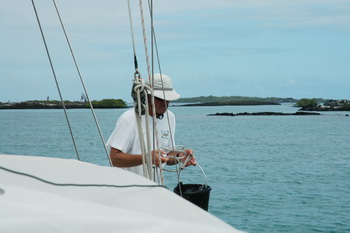
Rocky islets beyond Tenaya

Sea lions in the anchorage
We can see the penguin colony from the boat but are not allowed to approach in our dinghies. Instead we must follow the Galapagos National Park rules and go with a guide. So we did.

Galapagos Penguin at Las Tintoreas
Las Tintoreas are the islets near the anchorage and part of the Galapagos National Park. The largest has a path around that is possible to visit with a guide. We went with Willmer, an Ecuadorian who has been here 20 years and speaks English quite well. He explained that we must stay on the path so as not to disrupt the marine iguana nests. Until he pointed them out we had not even noticed them. Slight indentions in the black volcanic sand, the females had dug holes, dropped their eggs and covered them.
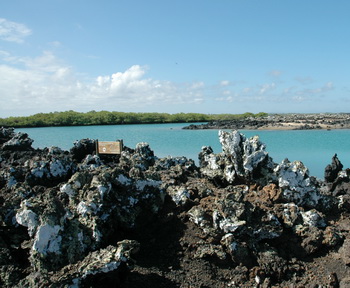
Las Tintoreas
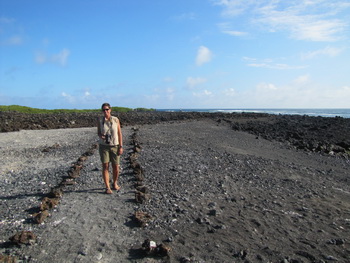
The trail at Las Tintoreas
The stark, barren landscape of black volcanic rock and sand is home to Galapagos Penguins, Blue-Footed Boobies, and Marine Iguanas. A light sandy beach bordered by mangroves is a favorite place for Galapagos Sea Lions. We saw pups swimming in the protected bay while many sea lions rested in the shade of the mangroves.
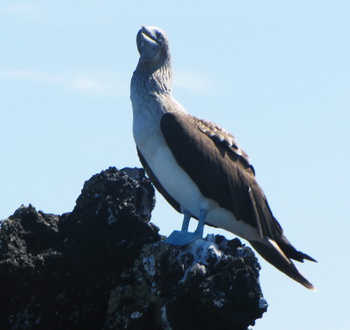
Blue-Footed Boobies

Blue-footed boobies, as their name suggests, have brilliant blue feet. Unfortunately our cameras did not capture them in the bright light of the mid-day sun. Well, maybe Mike's did but he shoots raw which overwhelms our simple program.
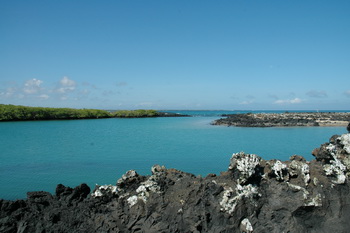
Bay at Las Tintoreas

Oh don't worry, we won't ...
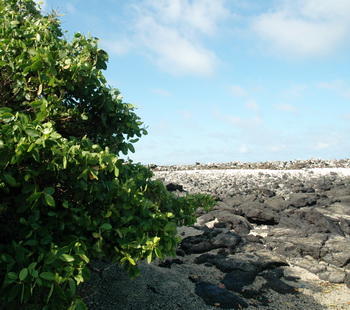
Mangroves at the sea lion's bay
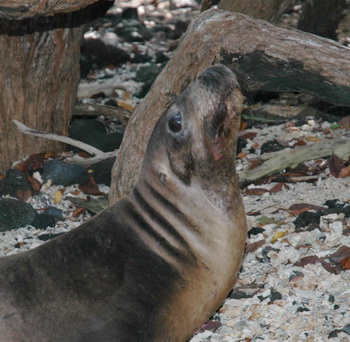
A sea lion under the mangroves
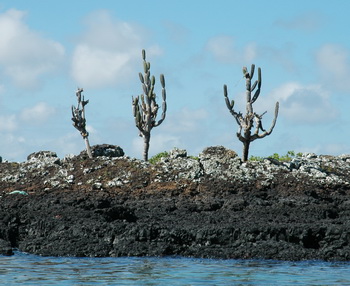
Cacti at Las Tintoreas
Very close to the embarcadero is a marvelous raised wooden trail called Concha de Perla that leads through the mangroves to a quiet snorkeling lagoon where we saw a penguin hunting fish. Marine Iguanas are everywhere, basking in the sun on the wooden planks or on the black pahoehoe lava. If bothered by the occasional human, they simply saunter away.

Marine Iguanas

Trail through the mangroves at Concha de Perla
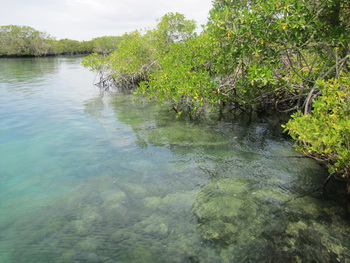
Lagoon at the end of the trail
.
Isabela is the largest of the Galapagos islands with its land surface accounting for half the archipelago's total. The only real road on the island leads from Puerto Villamil to the Sierra Negra Volcano and it is not possible for the average visitor to venture further north on the island.

Beginning our hike on Sierra Negra
Together with our guide, Willmer, and friends Frans and Lucia from s/y Dalwhinnie, we were on our way to Sierra Negra at 0700 to be the first on the trail at the rim of the volcano. At that early hour we stood a better chance of seeing birds Willmer said.
The road goes almost to the top of the 1200 meter volcano where there is a choice of two directions to walk along the rim. We chose the shorter route of 20 km. round trip to Volcano Chino, a smaller cone on the northwestern flank.
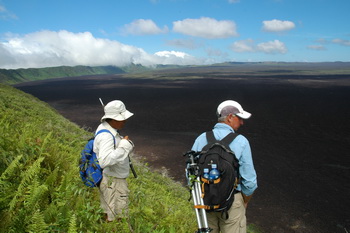
Willmer and Mike gaze into the caldera
The caldera at Sierra Negra is 12 km. across and is filled with pahoehoe lava of different colors ranging from a reddish brown to black, depending on the eruption. The most recent occurred in 2005. Willmer said lava flowed for 8 days into the caldera. It looks a bit like a dark lake in the center of the volcano complete with wind ripples.
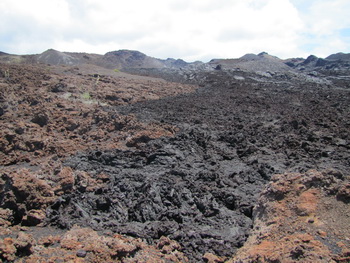
Different colored lava from different eruptions
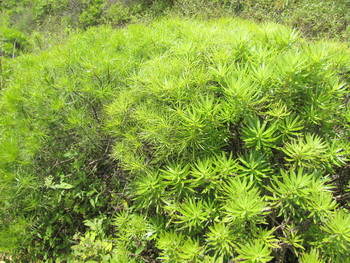
Endemic Darwin Shrubs found only on Sierra Negra
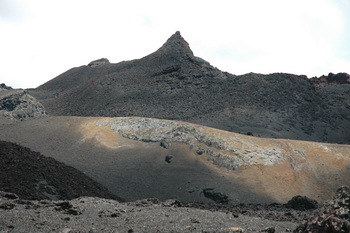
Cinder cone

Lava tunnel

Colorful volcanic rocks
Cabo Rosa and Los Tuneles are incredible landscapes formed from the lava flows of the Sierra Negra volcano. Arches, tunnels, pillars and collapsed lava tubes rise out of the shallow water as sea lions, rays and huge sea turtles move lazily about. Cacti dot the tops while mangroves grow at the edges. The scenery is absolutely gorgeous in a stark, primordial way.
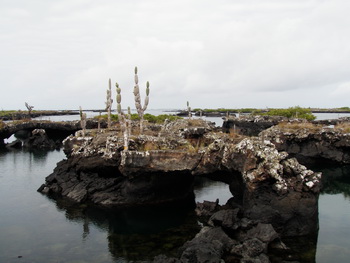
Arches and pillars at Cabo Rosa

After a 45 minute ride from the anchorage our guide and panga driver, Felicio, gave us a thrilling, high-speed ride through the surf, around the exposed rocks and through shallow water to reach the magical, tranquil destination. He motored slowly in and out of the multitude of small channels, stopping for us to take pictures of penguins and blue-footed boobies. We disembarked and wandered about the jagged black rocks admiring the incredible scenery. What an amazing place!
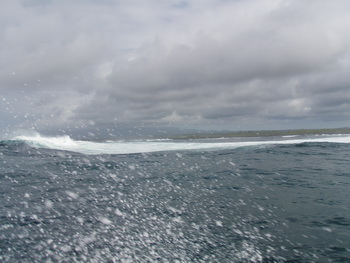
Speeding through the surf towards rocks and shallows

Mike in a panga at Cabo Rosa

Galapagos Penguins at Cabo Rosa

Katie and Jim standing on one of the arches
After about an hour at Cabo Rosa we hopped back in the panga and went a few miles further to get out of the Galapagos National Park so we could snorkel. Los Tuneles is also the result of Sierra Negra's eruptions. Hundreds of collapsed lava tubes, pillars, tunnels, arches and islets are separated by shallow, chilly water.
Everyone hopped into the water and went exploring. Jim and I went immediately to a short tunnel and swam through then meandered along the shore next to the mangrove roots. Felicio took us further along to some deeper grottos where we saw several White-Tipped Sharks very close up. Yikes! It was amazing but a little scary.
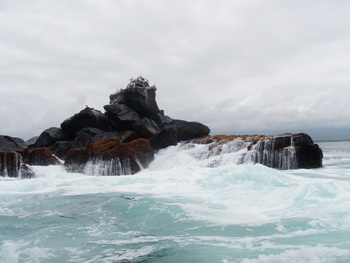
Union Rock
On the way back to the anchorage we circled Union Rock which lies just offshore. Sea Lions basked high up on the chunky rock while Nazca Boobies stood on top. Nazca Boobies have drab colored feet but are a brilliant white with black masks and wing tips.
The town of Puerto Villamil is small but has a certain simple charm. Several restaurants, a few bakeries and shops dot the unpaved roads.
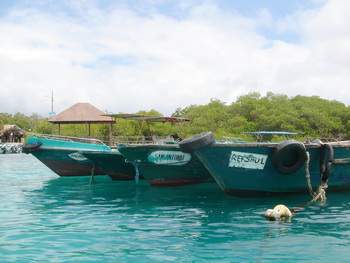
Pangas at the embarcadero

The main street of Puerto Villamil

Vegetarian fare is available at this restaurant
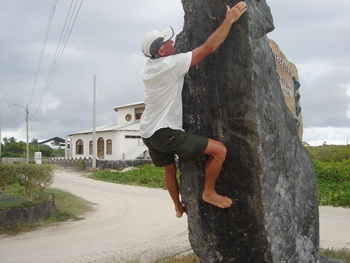
Two months on a boat without bouldering has Mike doing silly things
We have had an incredible time here in the Galapagos and it has been interesting learning about the flora and fauna as well as the geological, oceanic and atmospheric conditions.
Thursday Mike leaves his comfy bed at the hotel and comes back on board and we leave on the long passage to the Marquesas Islands in French Polynesia. As usual, Jim will update Tenaya Travels on Facebook via the SSB radio to let you know how we are doing.

Getting our international cruising permit to the Marquesas at the outside window.
These are the birds Jim and I have seen: Red-Footed Booby, Blue-Footed Booby, Nazca Booby, Noddy Tern, Galapagos Shearwater, Storm Petrel, Swallow-tailed Gull, Lava Gull, Magnificent Frigate, Brown Pelican, Cattle Egret, Great Blue Heron, Yellow-Crowned Night Heron, Striated Heron, White Cheeked Pintail, Whimbrel, Galapagos Hawk Vermillion Flycatcher, Smooth-Billed Ani, Galapagos Martin, Yellow Warbler, Small Ground Finch, Medium Ground Finch, Small Tree Finch, Medium Tree Finch, Woodpecker Finch, San Cristobal Mockingbird, Galapagos Mockingbird, Flamingo and, best of all, the Galapagos Penguin. I would have liked to have seen a Flightless Cormorant. Guess I'll have to come back.
These are the fish Jim and I have seen: Hammerhead Shark, Black-Tipped Shark, White-Tipped Shark, Galapagos Shark, Spotted Eagle Ray, Fine Spotted Moray Eel, Stone Scorpionfish, Balloonfish, Concentric Puffer Fish, Panamic Sergeant Major, Hieroglyphic Hawkfish, Blue-Chinned Parrotfish, Bicolor Parrotfish, Galapagos Grunt, Large Banded Blenny, Streamer Hogfish,Yellow-tailed Damselfish, Razor Surgeonfish, Threebanded Butterflyfish, Black Striped Salema, Rainbow wrasse, Chameleon Wrasse, Graybar Grunt and King Angelfish as well as many I couldn't remember.
Go to May 2010 Part One Pacific Crossing
The required paperwork and costs for cruising in the Galapagos
.